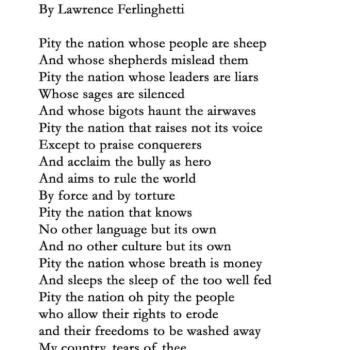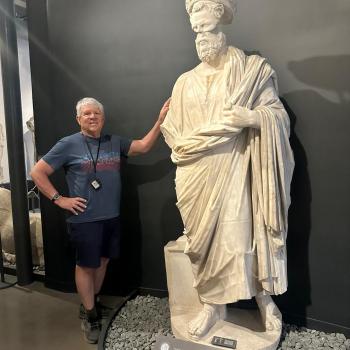C. The Scope of Scobie
Reading Scobie is a cautionary tale for this writer because too few people have read him because of the girth of his study on Biblical Theology— over 1,000 pages! It is in some ways appropriate that we end this long odyssey with a discussion of his work, which really is the only full dress comprehensive Biblical Theology available these days which is conversant with most of the relevant literature and approaches the subject with a critical rigor to produce competent results.
Providentially, Scobie writes is a very readable manner, and so it is not difficult to understand what he is trying to convey. This one volume which was completed after Scobie retired reflects the good fruit of a lifetime of studying and teaching the Bible. Scobie is a NT scholar with a great love for the OT, and his approach to Biblical Theology is characterized by deep thought and a real grasping and grappling with the nettle. His is a thematic approach, rather than a narratological approach to Biblical Theology. He adds that the “main goal of Biblical theology is to hear the two different voices of Old Testament and New Testament in their canonical integrity, yet also to understand them as both witnesses to the one divine reality of Jesus Christ.”
This comports with his definition of Biblical Theology, namely that Biblical Theology is not merely a theology based on the Bible, but rather it is theology contained in the Bible, and more specifically “the ordered study of what the Bible has to say about God and his relationship to the world and to humankind.” Scobie approaches Biblical Theology as an intermediate discipline “lying between the historical study of Scripture and the appropriation of the biblical message in the life and work of the Church, including the preaching of the Word.” This is an interesting approach, as normally Biblical Theology would be seen as the middle term between Biblical Studies and something like Systematic theology, and it reflects Scobie’s profound concern that Biblical Theology be done for the sake of the church. I would suggest it can be done for both the academy and the church, and I would also suggest that Biblical Theology needs to be done as a basis for and in dialogue with Systematic Theology or otherwise we will continue to have the problem of Systematic Theology being done in a way that does not do justice to the historical and exegetical particulars of the Biblical text.
Scobie begins his study by stating his conviction that Biblical Theology must be based only on the canonical text of Scripture. He allows that extra-Biblical sources can help us understand Biblical Theology, but Scobie, like for instance Brevard Childs is doing a form of canonical theology. In this regard he pays less attention to the sort of ANE material Richter finds crucial for understanding, and more attention to detailed exegesis of particular Biblical texts. As both Scobie and Mead have chosen, the study of and construction of a Biblical Theology is a modern preoccupation. Indeed the phrase Biblical Theology does not even show up until W.J. Christmann used it in 1629. Scobie is fully cognizant of the history of the discussion of this subject since that time, and he is not persuaded by the naysayers who suggest that the Bible is too diverse a corpus of literature to be able to find a singular Biblical Theology within it.
He is indebted to Childs in his approach in that he to believes that Biblical Theology must concentrate on the final form of the text, not what is behind the text. One of the problems of course with this approach is that Bible comes from many different historical contexts and the meanings of the words in the Bible are in fact conditioned by those contexts—not merely by the immediate literary context in a particular Biblical book, or even the larger literary context of the Bible as a whole, but by the larger historical, religious, social, rhetorical contexts. To focus on apparent Biblical themes to the neglect of hearing these various texts in their various contexts always runs into the danger of stripping the real nuances and contextual dimensions of the theologizing that is being done into specific contexts.
Scobie, to his credit, does not skimp on the contextual exegetical study of the Bible on the way to his presentation of Biblical Theology. At the same time, he knows that the fundamental presupposition to doing Biblical Theology at all is a high view of Scripture and a conviction that it is God’s Word, and so has a unity to it. “The presuppositions of this study include belief that the Bible conveys a divine revelation, that the word of God in Scripture constitutes the norm of Christian faith and life, and that all the varied material of the OT and NT can in some way be related to the plan and purpose of the one God of the whole Bible.” It becomes clear the further one reads into Scobie’s magnum opus that he clearly sees that Biblical Theology is not just the summing up of OT theology plus NT theology, but a much more synthetic project of creating a whole canon theology. The question is whether this can be accomplished without denuding the OT and NT theologies of their distinctive characters and contributions. Scobie’s answer is “What is maintained here is that BT [Biblical Theology] can both do justice to the OT and hold that, in the context of the canon, the NT is its continuation and fulfillment.” This hints to some degree at his approach which will assume more continuity than discontinuity between the testaments and their respective theologies. He is right as well that the Jewish approach to TANAK which focuses on the ‘T’ or Torah/Law portion of the canon differs considerably from the Christian approach to the OT which generally focuses on the salvation history beginning with creation, Fall, and then the long chronicling of God’s rescue operation with his people. “The addition of the NT of course shifts the central focus of God’s revelation away from the Torah to the Christ event witnesses to primarily in the Gospels. The whole OT is now seen as preparing for and pointing this event.” The very arrangement of the OT by Christians in a different order than by Jews is a theological move which helps make the point that the Biblical center of gravity has shifted in the canon.
Scobie divides up the approaches to Biblical Theology under three headings: 1) systematic; 2) historical; and 3) thematic, the latter of which he clearly favors. Scobie clearly recognizes that are problems with all three sorts of approaches, and in fact the thematic approach is a relatively new approach, whereas the oldest of the three is clearly the systematic approach which began with and after the Lutheran Reformation (e.g. with Melanchthon). He admits that it is relatively easy to come up with a center or focal theme of the NT, namely Christ or more broadly Christology, but more difficult to do so for the OT, with scholars like Walter Eichrodt saying there is no center or focal point for OT theology. Perhaps the oldest assertion that there is one, namely the recognition of covenant as a key theme (see above on Richter). But as Scobie says “’covenant’ is not an all pervasive theme in the OT, and parts… [of the OT] are linked with it in an artificial way” (think especially of the Wisdom Literature or the Psalms), and “covenant is even less of a pervasive theme in the NT than in the Old.” He is absolutely right about this, but at least this theme is mentioned in the two testaments whereas the phrase Kingdom of God, which has sometimes been used as a thematic rubric for doing Biblical Theology is a phrase not found anywhere directly in the OT (though the idea is present in Dan. 7 for example), and is only a dominant theme in the NT in the Synoptic Gospels. Scobie complains “It is difficult to understand the obsession with finding one single theme or ‘center’ for OT and NT theology, and more so for an entire BT….An approach that recognizes several themes would appear to be more productive”. Still, efforts are being made to find one overarching key theme, for example, Richter appears to be unique in focusing on the theme of Eden, while using the organizing device of the covenants.
Scobie believes that it is the task of Biblical Theology that one must explore the relationship between the OT and NT, and so it is no surprise that the theme he focuses on, promise and fulfillment, necessarily spans the two testaments and is not to be fully found in either singular testament. This might almost be called a theology which unites the testaments, rather than describes the OT and NT theologies found in the two testaments.
Scobie does not think that the theme of salvation history is adequate if taken as the major theme of the Bible, not least because not only does salvation in the NT sense of conversion to Christ not occur in the OT, but even more broadly redemption usually means something ‘less’ spiritual in the OT than it does in the NT. He cautions “Scripture is concerned not just with God’s relation with his chosen people, but with his relation to the whole world that he has created and to all humankind…. The relation of God to his people does not just involve ‘salvation’…it is also a history of disobedience and so judgment. [And]
The significance of salvation history for the NT is a matter of dispute” except when one is talking about Luke-Acts. Brevard Childs provides a helpful cautionary word at this juncture when he says that the task of Biblical Theology is “not to Christianize the Old Testament by identifying it with the New Testament witness, but to hear its own theological testimony to the God of Israel whom the Church confesses also to worship.”
In describing his own approach Scobie emphasizes “the structure proposed here is one in which the major themes of the OT and NT are correlated with each other. Minor themes are then grouped around the major ones. Extensive study of key biblical themes again and again reveals a common pattern in the way these themes are developed within Scripture.” One of the basic organizing principles will be the use of typology, seeing OT events, persons, institutions as patterns and example and foreshadowings of NT ones and thus one looks for both theological and historical correspondence, with the usual assumption that the antitype is grander and a fulfillment of the type.
One of the helpful distinctions made in this study is the one between promise and predictive prophecy. Chris Wright describes the difference as follows:
Imagine in the last century a father promises his young son a horse of
his own when he comes of age! In the meantime, cars are invented. On his twenty-first birthday, his father therefore gives him a car instead. The promise is fulfilled, because the substantive meaning of the promise was a personally owned means of transport. It would be pointless to say it would only be fulfilled if the son gets a horse as well, or later. That would be to take the original promise as a mere prediction which will have ‘failed’ unless it is literally honoured.
The point of this illustration is clear—promise is a broader category than predictive prophecy, and its fulfillment need not take an absolutely literal or exact form. This is presumable why Scobie chooses the category of promise and fulfillment as his unifying theme, not least because, as Paul says, in Christ all sorts of and every one of God’s promises are a yes (2 Cor. 1.20). Scobie sees the already and not yet character of fulfillment in both testaments as a clue that promise and fulfillment is something that can be said of both testaments in isolation but also together, with presumably the NT being more about fulfillment, the OT more about promise and prophecy. Scobie claims that this theme or structuring device is not imposed on the text, but arises out of the text.
With this rubric Scobie then identifies four master themes: 1) God’s order (both the creation and the historical and eschatological one); 2) God’s Servant (whether prophet, priest or king, or even Israel, and culminating in the Suffering servant, Christ, the ultimate mediator between God and humankind); 3) God’s People (under this heading he sees subthemes such as covenant or election, land, city, worship); 4) God’s Way (piety, spirituality, ethics, ethos). This last category is Scobie’s attempt to do justice to the overwhelmingly large amount of paraenetic material in both testaments, and here he stresses the connection between theology and ethics following Childs who says “the Old Testament portrayal of ethical behavior is inseparable from its total message respective Israel, that is to say from its theological content”.
This study has validated that statement as just as true for the NT as it is for the OT. The only ethics we have in the NT are theological ethics— the two things are intimately intertwined, and to Scobie’s credit, he sees this truth and affirms it.
The four themes as listed above are viewed as proclaimed or declared and promised in the OT, partially fulfilled there, and then further fulfilled in the NT era, but all await the eschatological consummation for their complete fulfillment. What is promised in the OT then is a new order, a new servant, a new people, and a new way, and all of these are partially fulfilled in and through the Christ event, but they await the consummation for the full completion of what was promised. Thus the OT and NT eras share the characteristic of being already and not yet.
Here we get a glimpse of what is fundamentally wrong with Scobie’s approach. Even if we grant all the above, it leaves out of consideration what precipitated the whole need for such promises—namely the Fall. And furthermore, it is not the creation order, but rather the fallen creation order that needs redeeming. My point is this— without the narratological scheme which is tri-partite (creation, fall, redemption) we have not done justice either to the narrative flow of the testaments, or to the two dramatic events that precede the need for promise and fulfillment, and indeed for salvation history.
There is the further problem as well that one could certainly debate the clustering of various of the subthemes with this or that big four pigeonhole. The big four themes are quite generic and defined too broadly, and become catch-alls for all sorts of ideas, not because there is not some connection say between God’s people as a theme and worship as a theme but because this heuristic device does not allow one to see that various of these so-called subthemes are connected to the other major themes as well.
And furthermore, even when one is dealing with a big theme like the people of God, one has to ask where one is in the story to meaningfully talk about that topic. In the NT era, Paul defines the people of God as Jew and Gentile united in Christ. This definition will hardly work for the OT people of God. In other words, I am unconvinced that this sort of schematized and carefully categorized thematic approach is as helpful as the narratological one. In the end a thematic approach is just another form of a topical approach, however carefully one has co-ordinated sub-themes under the headings of major themes, and as such bears considerable resemblance to the old systematic categorization of ideas and topics. Scobie just doesn’t operate with purely soteriological categories (justification, sanctification, glorification) or some of the other schemas old school systematic theology used to sort the Biblical data.
The Bible of course does not organize itself thematically or topically, and the real danger of this whole sort of approach is not merely ignoring where in the story this or that theme appears, but also how differently it is treated in this phase of the story from a later phase. There is also the danger of ignoring the genre of material in which an idea occurs and how that changes the nature of the discussion and the theme. For example, a promise in a covenant document is one thing—that’s a legally binding contract. A conditional promise in an apocalyptic letter of John of Patmos to his converts, contingent on their believing and behaving more properly, is another. Some promises are conditional, some are not. The ones in a covenant may well be taken literally (‘if you disobey me you will die’) whereas in a document of apocalyptic prophecy one is not meant to take the images, ideas, and themes literally. There is no real dragon to chase around a real woman in the wilderness, but the promise of spiritual protection conveyed in this apocalyptic visionary story form in Rev. 12 is certainly real.
What we find in Scobie’s study is a massive amount of carefully sifted data, fully conversant with the history and the current state of scholarly discussion on that data. Texts are helpfully exegeted and interpreted, and indeed the study is well written and is done in a way that not only makes it accessible to a wide audience, but it often has a helpful pastoral thrust to it. At the end of the day however, reading Scobie is like reading a Biblical Theology dictionary with a pastoral heart on this or that topic, and then following the bold print allied topics listed at the end of the article for further elucidation and connections. This is helpful, but it may be doubted that it is the best way to connect the dots of Biblical Theology. The great promise (and fulfillment!) of Scobie’s study is that he shows there are a lot of intricate connections between the two testaments, and between various themes found in each testament. The ‘not yet’ of Scobie’s study is showing why this or that theme appears where it does in the story, and why the theme modulates and changes as the Biblical story develops, climaxes, and heads for an eschatological conclusion.
In closing we would do well to consider the carefully chosen words of Frank Mead about the problems with thematic approaches to Biblical Theology:
First, the sheer number and diversity of themes that biblical theologians have identified and discussed makes it difficult to do justice to the breadth and depth of the Bible’s theology. Even if one limited the scope only to the proposed ‘centers’ or major themes, the amount of material would be quite large indeed…. Second, the multiplicity of methods also affects the choice and arrangement of the themes….Third, the relationship of the testaments becomes acute when we address biblical themes, because very important categories do not easily carry over between the Old and New Testaments. For example, the messianic identity of Jesus, the nature of the resurrection, and the worldwide scope of the church’s mission are significant in the New Testament message, but where should they be considered in relation to Old Testament themes?
Where indeed. Perhaps after all the correlation of themes into slots, however clarifying in some ways, is not at the end of the day the best way to do Biblical Theology.
George Herbert, the great English cleric and metaphysical poet once wrote a sonnet entitled ‘The Holy Scriptures’. It reads in part
Oh that I knew how all thy lights combine.
And the configuration of their glorie!
Seeing not onely how each verse doth shine,
But all the constellation of the storie.
Ladies, look here ; this is the thankfull glasse,
That mends the lookers eyes : this is the well
That washes what it shows. Who can indeare
Thy praise too much ? thou art heav’ns Lidger here,
Working against the states of death and hell.
Such are thy secrets, which my life makes good,
And comments on thee : for in ev’ry thing
Thy words do finde me out, and parallels bring,
And in another, make me understood.
It is a consummation devoutly to be wished that we might see the full constellation of the Biblical story, but as of yet we are only pilgrims on the way to such a capacious vision, and Biblical Theology may well help us get there, but as for now, it has ‘miles to go… and promises to keep’ as Robert Frost once said. In the meanwhile, we must apply the whole of the text to ourselves and the whole of ourselves to the Biblical text, as Johannes Bengel insisted, and what we repeatedly discover when we do is that the Biblical text uncovers and discovers us, or as Herbert more eloquently puts it “Thy words do finde me out, and parallels bring, And in another make me understood.”
Lord may we understand not just your Word, but ourselves in the light of your Word, written and incarnate, and so become what we admire, mirrors of Christ, bearers of the indelible and restored image. AMEN.













